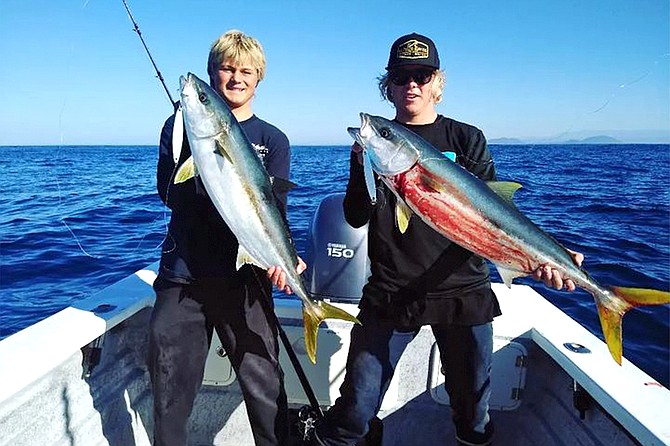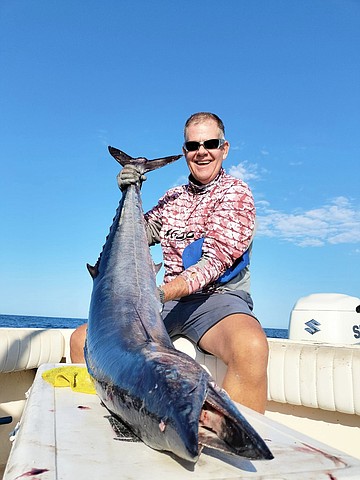 Facebook
Facebook
 X
X
 Instagram
Instagram
 TikTok
TikTok
 Youtube
Youtube

Dock Totals 11/5 – 11/11: 1425 anglers aboard 74 half-day to 3-day trips out of San Diego landings over the past week caught 1359 bluefin tuna (up to 207 pounds), 32 calico bass, 22 dorado, 1 lingcod, 17 lobster (14 released), 32 perch, 108 rock crab, 3404 rockfish, 82 sand bass, 29 sanddab, 401 sculpin, 82 sheephead, 652 whitefish, 81 yellowfin tuna, and 5 yellowtail.
Saltwater: While the long-range boats are beginning their winter schedule of further trips down the Baja coast for excellent yellowfin, wahoo, yellowtail and grouper fishing, the 3-day and shorter fleet has been doing very well on bluefin tuna and deep-drop rockfish. This past week, the fleet concentrated on the areas near the Corner, some 40 to 50 miles due west of Point Loma and in line with the southeast-pointing finger of San Clemente Island. Limits of bluefin were caught by most who ventured outside, with crews finding fish from foaming school-sized tunas in the 20-30-pound range to deeper marks of fish to well over 200 pounds.
Yellowfin, dorado, and yellowtail, all species well-represented by the 1- to 3-day fleet the week previous, dropped in the counts to almost nil due to the great bluefin bite well north of where the warmer-water species are biting. So, the call was to either go west or go south, and with all that bluefin action, most boats went west. Everything from fly-lined live bait to yoyo irons and sinker rigs have been working on the bluefin, with the larger models coming around gray light in the am or pm for anglers fishing heavier gear deeper, and the smaller fish coming through the day more on the surface gear. If heading out on one of these bluefin trips, be sure to bring a range of tackle, from 25- to 30-pound fly-line setups to 100-pound heavy gear for the larger fish holding deeper in the water column.
Given the area and time remaining for the scheduled outing, many of the 1.5-day to 3-day boats have been turning to rockfish once they are full up on tuna. So, bringing a rockfish rig that is able to get down to the required 50-fathoms (300-feet) plus depths in U.S. waters is also recommended. For boats able to fish in Mexican waters, you can still fish shallower for rockfish, but the limit is reduced. Either way, whether going south or west, the 1.5-day to 3-day trips are rewarding anglers with a good mix of bluefin tuna and rockfish.
Outside of the bluefin that seem to be within range all year these past few years, our seasonal pelagics — yellowtail, yellowfin, and dorado — have been sliding further down the coast of Baja, retreating as the water cools toward the southern half of the peninsula. Still, from Ensenada south, anglers are finding flurries of yellowtail with a few yellowfin tuna mixed in, and that action only gets better the further south one goes. In the northern half of Baja’s Pacific side, San Quintin is producing well off the banks within 15 miles of the coast for the operations working out of the bay, like Garcia’s, Pedro’s, Jaime’s and K&M, for yellowtail on the yoyo iron and some occasional yellowfin. That’s pretty much the story heading down the coast from there: lots of yellowtail and rockfish and a few tuna. But once you get past Cedros Island off the Vizcaino Peninsula, the coastal towns from Bahia Tortugas and Bahia Asuncion and points south are pumping out great numbers of both tuna and jacks, with a few wahoo and dorado in the mix.

A little further south, in the La Bocana to Bahia Magdalena region, the more-tropical dorado and wahoo have been the main targets offshore, while fishing for both broomtail and gulf grouper inside has been excellent. Captain Juan Cook, working this month out of Lopez Mateos in Bahia Magdalena, has been consistently reporting great fishing on wahoo to 70 pounds just outside the bay, with most of the speedy fish coming on fast-trolled Madmacs at 12 knots or so. And when you’re not outside the bay chasing wahoo, dorado, and tuna, the inner bay holds some excellent grouper and snook fishing. It might seem like such a closed biosphere as Bahai Magdalena and other estuaries to the north would easily be fished out, but quite the opposite is true, as the co-ops in the area encourage catch-and-release fishing, especially on the gulf and broomtail grouper. And if it’s windy outside or you just want a short day of good fishing, the inner bays and lagoons of Baja Sur can be epic.
The bite just off the southern third of Baja has also been very productive for San Diego boats like the Intrepid, the Excel, and the Red Rooster III running 8-days or longer trips to fish the area. Whether driving down, flying down, or riding a long-range boat, the southern half of Baja on the Pacific side is where the action is if you’re looking for yellowfin tuna, wahoo, or dorado. Yellowtail fishing is best along the middle third of the peninsula, with a bit of tuna mixed in, while bluefin tuna are predominantly in US waters west of San Diego. This time of year, as angler numbers drop but the fishing is still going off, is a great time to book a trip, as there are more light loads giving anglers more elbow room on the deck. This can be especially true for those who are new to the Southern California brand of sportfishing and would like to learn, as crews can spend more one-on-one time with novices and help shorten the learning curve. They’re out there, so go get ‘em!


Dock Totals 11/5 – 11/11: 1425 anglers aboard 74 half-day to 3-day trips out of San Diego landings over the past week caught 1359 bluefin tuna (up to 207 pounds), 32 calico bass, 22 dorado, 1 lingcod, 17 lobster (14 released), 32 perch, 108 rock crab, 3404 rockfish, 82 sand bass, 29 sanddab, 401 sculpin, 82 sheephead, 652 whitefish, 81 yellowfin tuna, and 5 yellowtail.
Saltwater: While the long-range boats are beginning their winter schedule of further trips down the Baja coast for excellent yellowfin, wahoo, yellowtail and grouper fishing, the 3-day and shorter fleet has been doing very well on bluefin tuna and deep-drop rockfish. This past week, the fleet concentrated on the areas near the Corner, some 40 to 50 miles due west of Point Loma and in line with the southeast-pointing finger of San Clemente Island. Limits of bluefin were caught by most who ventured outside, with crews finding fish from foaming school-sized tunas in the 20-30-pound range to deeper marks of fish to well over 200 pounds.
Yellowfin, dorado, and yellowtail, all species well-represented by the 1- to 3-day fleet the week previous, dropped in the counts to almost nil due to the great bluefin bite well north of where the warmer-water species are biting. So, the call was to either go west or go south, and with all that bluefin action, most boats went west. Everything from fly-lined live bait to yoyo irons and sinker rigs have been working on the bluefin, with the larger models coming around gray light in the am or pm for anglers fishing heavier gear deeper, and the smaller fish coming through the day more on the surface gear. If heading out on one of these bluefin trips, be sure to bring a range of tackle, from 25- to 30-pound fly-line setups to 100-pound heavy gear for the larger fish holding deeper in the water column.
Given the area and time remaining for the scheduled outing, many of the 1.5-day to 3-day boats have been turning to rockfish once they are full up on tuna. So, bringing a rockfish rig that is able to get down to the required 50-fathoms (300-feet) plus depths in U.S. waters is also recommended. For boats able to fish in Mexican waters, you can still fish shallower for rockfish, but the limit is reduced. Either way, whether going south or west, the 1.5-day to 3-day trips are rewarding anglers with a good mix of bluefin tuna and rockfish.
Outside of the bluefin that seem to be within range all year these past few years, our seasonal pelagics — yellowtail, yellowfin, and dorado — have been sliding further down the coast of Baja, retreating as the water cools toward the southern half of the peninsula. Still, from Ensenada south, anglers are finding flurries of yellowtail with a few yellowfin tuna mixed in, and that action only gets better the further south one goes. In the northern half of Baja’s Pacific side, San Quintin is producing well off the banks within 15 miles of the coast for the operations working out of the bay, like Garcia’s, Pedro’s, Jaime’s and K&M, for yellowtail on the yoyo iron and some occasional yellowfin. That’s pretty much the story heading down the coast from there: lots of yellowtail and rockfish and a few tuna. But once you get past Cedros Island off the Vizcaino Peninsula, the coastal towns from Bahia Tortugas and Bahia Asuncion and points south are pumping out great numbers of both tuna and jacks, with a few wahoo and dorado in the mix.

A little further south, in the La Bocana to Bahia Magdalena region, the more-tropical dorado and wahoo have been the main targets offshore, while fishing for both broomtail and gulf grouper inside has been excellent. Captain Juan Cook, working this month out of Lopez Mateos in Bahia Magdalena, has been consistently reporting great fishing on wahoo to 70 pounds just outside the bay, with most of the speedy fish coming on fast-trolled Madmacs at 12 knots or so. And when you’re not outside the bay chasing wahoo, dorado, and tuna, the inner bay holds some excellent grouper and snook fishing. It might seem like such a closed biosphere as Bahai Magdalena and other estuaries to the north would easily be fished out, but quite the opposite is true, as the co-ops in the area encourage catch-and-release fishing, especially on the gulf and broomtail grouper. And if it’s windy outside or you just want a short day of good fishing, the inner bays and lagoons of Baja Sur can be epic.
The bite just off the southern third of Baja has also been very productive for San Diego boats like the Intrepid, the Excel, and the Red Rooster III running 8-days or longer trips to fish the area. Whether driving down, flying down, or riding a long-range boat, the southern half of Baja on the Pacific side is where the action is if you’re looking for yellowfin tuna, wahoo, or dorado. Yellowtail fishing is best along the middle third of the peninsula, with a bit of tuna mixed in, while bluefin tuna are predominantly in US waters west of San Diego. This time of year, as angler numbers drop but the fishing is still going off, is a great time to book a trip, as there are more light loads giving anglers more elbow room on the deck. This can be especially true for those who are new to the Southern California brand of sportfishing and would like to learn, as crews can spend more one-on-one time with novices and help shorten the learning curve. They’re out there, so go get ‘em!
Comments